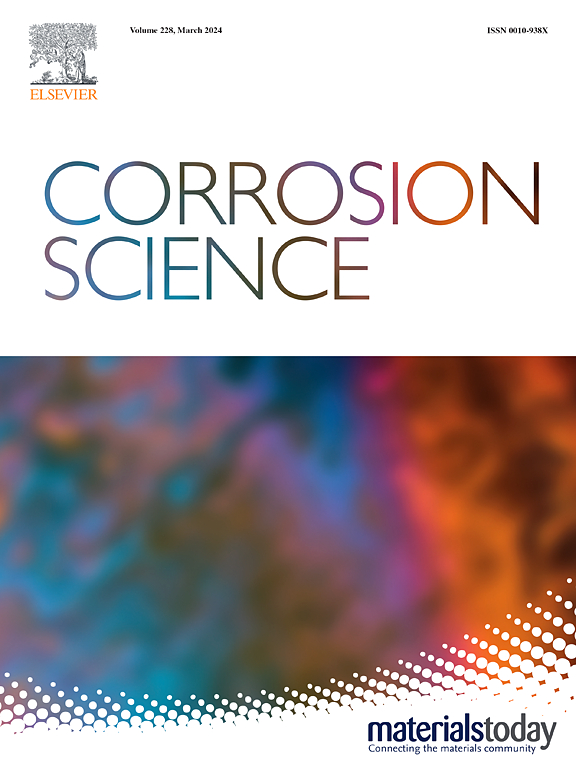Effect of Heating Rates on Non-Isothermal and Isothermal Oxidation Behavior of Additive Friction Stir Deposited Nickel Base Superalloy IN625
IF 7.4
1区 材料科学
Q1 MATERIALS SCIENCE, MULTIDISCIPLINARY
引用次数: 0
Abstract
This study examined the effects of non-isothermal heating in air on formation of oxide layers on additive friction stir deposited (AFSD) IN625 as compared with the conventionally fabricated IN625 feed material. Oxidation kinetics and characteristics when heated to 1000 °C, at heating rates of 10, 100, and 1000 °C/min followed by isothermal holding at 1000 °C on the oxidation behavior and oxide species formation were evaluated in both feed and additive friction stir deposited IN625 alloy. The AFSD IN625 alloy experienced lower oxidation compared to the feed IN625 material under similar conditions due to the significantly smaller grains forming a uniform protective oxide layer during non-isothermal heating. Oxidation during isothermal heating followed a parabolic growth law in IN625 supporting Wagner’s oxidation theory. X-ray photoelectron spectroscopy and energy-dispersive X-ray spectroscopy studies revealed oxidation of almost all major alloying elements, with chromia being the predominant species. Interestingly, the formation of a continuous layer of NiO on top of chromia at 10 °C/min and 100 °C/min was observed in feed IN625, while in additive friction stir deposited discrete islands of NiO was formed. The material condition influenced the oxidation behavior while the evolution of oxides was influenced by the combined effects of heating rate and thermal kinetics. This experimental approach was designed to evaluate the material response to rapid, short-duration, and high-temperature oxidation, offering insights into the dynamic oxidation behavior of AFSD IN625 under varying thermal conditions.
升温速率对添加搅拌摩擦沉积镍基高温合金IN625非等温和等温氧化行为的影响
本研究考察了空气中非等温加热对添加剂搅拌摩擦沉积(AFSD) IN625氧化层形成的影响,并与传统制造的IN625原料进行了比较。在加热到1000°C,加热速率为10、100和1000 °C/min时,在1000°C等温保温下,对进料和添加剂搅拌摩擦沉积IN625合金的氧化行为和氧化物形成进行了氧化动力学和特性的评估。AFSD IN625合金在非等温加热过程中形成了均匀的保护氧化层,因此在类似条件下,与进料IN625材料相比,AFSD IN625合金的氧化程度更低。等温加热过程中的氧化遵循IN625的抛物线生长规律,支持瓦格纳的氧化理论。x射线光电子能谱和能量色散x射线能谱研究表明,几乎所有主要合金元素都发生了氧化,其中以铬元素为主。有趣的是,在10 °C/min和100 °C/min条件下,进料IN625在铬上形成了连续的NiO层,而在添加摩擦搅拌中形成了离散的NiO岛。材料条件影响氧化行为,而升温速率和热动力学共同影响氧化物的演化。该实验方法旨在评估材料对快速、短时间和高温氧化的响应,从而深入了解AFSD IN625在不同热条件下的动态氧化行为。
本文章由计算机程序翻译,如有差异,请以英文原文为准。
求助全文
约1分钟内获得全文
求助全文
来源期刊

Corrosion Science
工程技术-材料科学:综合
CiteScore
13.60
自引率
18.10%
发文量
763
审稿时长
46 days
期刊介绍:
Corrosion occurrence and its practical control encompass a vast array of scientific knowledge. Corrosion Science endeavors to serve as the conduit for the exchange of ideas, developments, and research across all facets of this field, encompassing both metallic and non-metallic corrosion. The scope of this international journal is broad and inclusive. Published papers span from highly theoretical inquiries to essentially practical applications, covering diverse areas such as high-temperature oxidation, passivity, anodic oxidation, biochemical corrosion, stress corrosion cracking, and corrosion control mechanisms and methodologies.
This journal publishes original papers and critical reviews across the spectrum of pure and applied corrosion, material degradation, and surface science and engineering. It serves as a crucial link connecting metallurgists, materials scientists, and researchers investigating corrosion and degradation phenomena. Join us in advancing knowledge and understanding in the vital field of corrosion science.
 求助内容:
求助内容: 应助结果提醒方式:
应助结果提醒方式:


